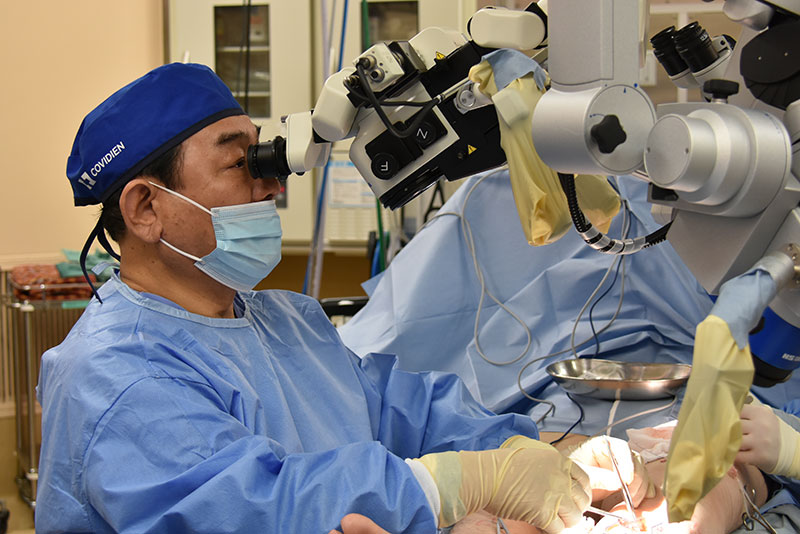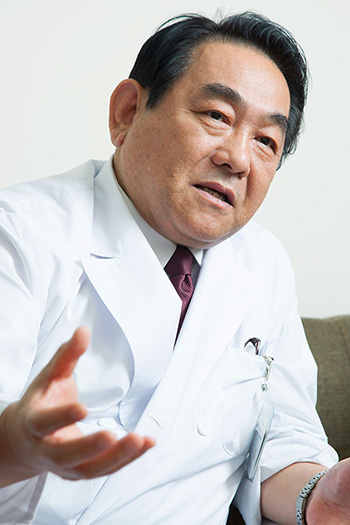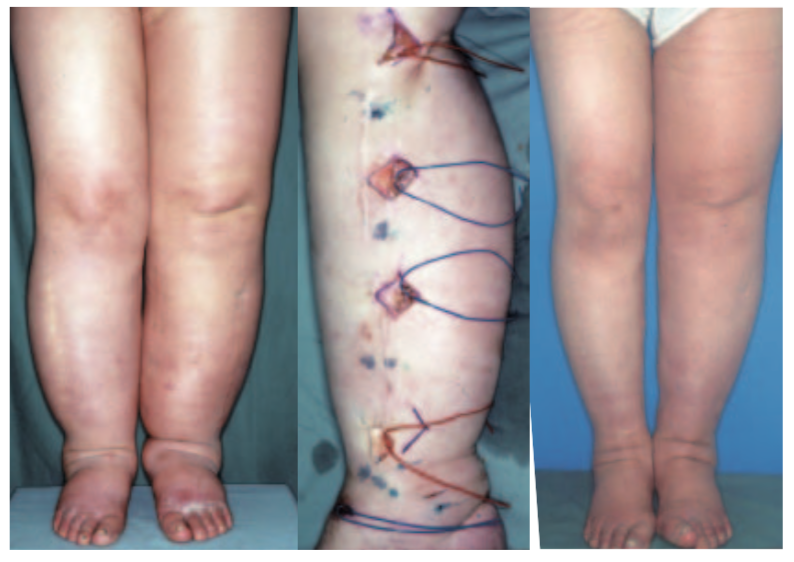Developing Supermicrosurgical Instruments to Save Lymphedema Patients
– Micro forceps for use with ultra-fine 0.03mm needles –

Developing Supermicrosurgical Instruments to Save Lymphedema Patients
We work on developing forceps capable of handling the world’s finest surgical needles and sutures.
- Target Amount
- US$ 45,000
- Started since
- 2019/6/1
*Updates on Dr.Koshima’s schedules: Report for Jan to June in 2019 / Conferences in 2019 / Conferences in 2020
Project Summary

(c) Soichiro Negishi, Chiyu Vol.28
Dr. Isao Koshima, Emeritus Professor of the University of Tokyo, is known as one of the most pioneering plastic surgeons in the supermicrosurgery field. He has been developing novel surgical techniques for lymphedema and other conditions, using custom-made supermicrosurgical instruments.
Dr. Koshima and a team of doctors and medical equipment manufacturers started this project to develop commercial medical instruments for supermicrosurgery, to treat lymphedema in particular. There are several surgical treatment options involved, such as lymph-venous anastomosis (LVA), the creation of new connections between the lymphatic and venous system, LVA transplant, lymphatic vessel transplantation, and, vascularized lymph node transfer (VLNT).
We are currently working on developing forceps capable of handling the world’s finest surgical needles and sutures, where the needles are 0.03mm and the sutures are 0.012mm in diameter. Eventually, we aim to produce a series of microsurgical instruments for surgeons to use in the ever expanding supermicrosurgery field.
Dr. Koshima’s Surgical Techniques and Instruments
To learn about and to acquire supermicrosurgery techniques, more than 350 surgeons from all over the world visit Dr. Koshima to be trained every year. Dr. Koshima has been invited to perform live-surgery sessions and presentations in the U.S, Europe, Middle-East and Asia, on more than 250 occasions in total. In addition to attending to patients in Japan, he also visits many other countries to perform supermicrosurgeries. Since 1997, he has been invited to perform surgeries at over 30 hospitals and clinics in more than 18 countries and regions around the globe.

This image illustrates microvascular anastomosis, one of Dr. Koshima’s supermicrosurgery techniques. Supermicrosurgery is becoming recognized as a first-option surgical treatment for patients with lymphedema. With lymphedema, the most important objective is to secure lymph flow through the connected vessels, so that the swelling and pain is reduced.
For this type of surgery, surgeons require more than 15 kinds of instruments such as ultrafine surgical needles and sutures, needle holders, forceps, and others. Dr. Koshima develops supermicrosurgery tool designs in addition to techniques so that surgeons and trainees may efficiently acquire the skills necessary to perform supermicrosurgeries.
To turn these tool designs into commercial reality, Dr. Koshima started collaborating with small and medium-sized engineering and manufacturing companies, specializing in micro-processing technologies. The first steps in this project is the development of forceps to handle the ultra-fine 0.03mm surgical needles and 0.012mm sutures.
Project Goals
Develop supermicrosurgical instrument prototypes for international field testing
Supermicrosurgery requires high levels of dexterity with a subtle sense of strength control. Surgical tools need to cover these requirements.
Dr. Koshima started working on supermicrosurgery forceps design with Japanese companies specializing in micro-processing engineering and technologies, to develop and build commercial prototypes based on his own custom instrument.
We aim to provide prototype sets to key opinion leader (KOL) surgeons internationally, for field testing to secure feedback and opinions, and to help improve the instrument design.
Spread awareness of supermicrosurgery to lymphedema patients around the world
Lymphedema can cause the swelling of arms and legs due to non-draining lymph fluids. It can result as a side effect from cancer therapies and radiation therapies to lymph nodes. Patients’ quality of life (QoL) may be severely impacted by this chronic condition.
To save patients with lymphedema, Dr. Koshima has been devoting his time to train and educate medical students, young surgeons and medical practitioners so as to pass his supermicrosurgical technique down to the next generation of surgeons. He has adopted hundreds of trainees from around the globe, and, actively and frequently travels overseas to perform surgeries and training sessions.
To help Dr. Koshima spread the word of supermicrosurgery as a first-option surgical treatment for patients with lymphedema, we need to produce brochures and pamphlets, videos, training materials and such. Not only do we need to increase the number of supermicrosurgery-capable surgeons around the globe, we also need to spread awareness of this surgery option to patients suffering from lymphedema.
Non-surgical treatment, including manual lymphatic drainage, exercise, and the use of compression sleeves and garments, have been applied against lymphedema for decades. Today, patients with lymphedema have surgical treatment as one of the options. We aim to spread the word to raise awareness of supermicrosurgery through this campaign.
Your Donation
Your donation will be used to take below actions to help patients suffering from lymphedema.
With total cumulative donation of 27,000 USD, we would:
- Develop and build three commercial prototype sets of supermicrosurgery forceps, to be used with ultra-fine 0.03mm surgical needles and 0.012mm sutures, based on Dr. Koshima’s custom instrument design. We would then provide these prototypes to three KOL surgeons internationally, for field testing to secure feedback and opinions, and to help improve the design.
With total cumulative donation of 45,000 USD, we would:
- Develop and build five commercial prototype sets of supermicrosurgery forceps, to be used with ultra-fine 0.03mm surgical needles and 0.012mm sutures, based on Dr. Koshima’s custom instrument design. We would then provide these prototypes to five KOL surgeons internationally, for field testing to secure feedback and opinions, and to help improve the design.
With total cumulative donation of 65,000 USD, we would:
- Develop and build five commercial prototype sets of supermicrosurgery forceps, to be used with ultra-fine 0.03mm surgical needles and 0.012mm sutures, based on Dr. Koshima’s custom instrument design. We would then provide these prototypes to five KOL surgeons internationally, for field testing to secure feedback and opinions, and to help improve the design.
- We would produce English-based brochures and videos on Dr. Koshima’s supermicrosurgery techniques and instruments targeting medical students, doctors and surgeons.
- We would create web pages to disseminate above information materials, to spread awareness of supermicrosurgery for lymphedema, to doctors.
If the total donation amount does not meet the target requirements of these goals, we would hold the donations in escrow to be used in subsequent follow-up projects related to this project.
Please support us in helping lymphedema patients improve their quality of life (QoL). We are extremely grateful for your donation.
We offer several options to accept donations. To transfer money from outside of Japan, we recommend using PayPal. Bank transfers are also available for bank accounts in Japanese yen in Japan. Please contact us by filling in the form for more details of how to donate.
About Lymphedema
Lymphedema is the swelling of arms and legs caused by a collection of too much lymph fluid that does not drain properly. Lymphedema is a chronic condition, decreasing patients’ quality of life (QoL) significantly.
What causes Lymphedema?
The lymphatic system is a part of the circulatory system and vital for immune functions. It primarily consists of lymphatic vessels that function similarly to the circulatory system of veins and capillaries. The vessels are connected to lymph nodes where the lymph is filtered to remove bacteria, viruses and other foreign substances which may infect other organs to cause sicknesses. Lymphedema is caused by a blockage of this system.
Lymphedema commonly affects the arms or the legs. Some patients might experience swelling in the head, genitals, chest, or other areas of the body.
Lymphedema can be a side effect from receiving some types of cancer treatments such as lymphadenectomy (surgery removing lymph nodes), radiation therapies to lymph nodes, and cancer therapies.
When lymphedema affects the arms, patients experience difficulty performing basic tasks, such as holding eating utensils, due to swollen hands. If the legs are affected, simple walking can become a painful and tiring affair, due to swollen and heavy legs and feet. At the same time, onset of lymphedema may severely affect the patients’ body appearances, psychologically impacting the patient.
About Supermicrosurgery
Supermicrosurgery is a surgical technique involving dissection and anastomosis of very small vessels, such as making new connections between lymphatic vessels and venules, which can range from 0.3 to 0.8mm in diameter.
In recent years, supermicrosurgery is increasingly getting recognized as a first-option surgical treatment for patients with lymphedema. With supermicrosurgery, many patients experience relief from lymphedema symptoms including reduction of swelling of their limbs.
Supermicrosurgery requires surgeons to operate using ultrafine surgical needles and sutures, performed under the microscope. Supermicrosurgery techniques and procedures are extremely intricate and can be exceptionally difficult for surgeons to acquire.

These are photos of a patient with lymphedema affecting the legs. The left photo shows the patient before supermicrosurgery, but after 24 years of external compression and other types of physiotherapy to manage the swelling. The middle photo shows the patient undergoing supermicrosurgery. Apertures of 2 to 3 square cm are made at four points to locate and reconnect lymphatic vessels and venules. Lymph then flows through the connected vessels and the edema is reduced. The photo on the right shows the same patient nine years after the supermicrosurgery.
Supermicrosurgical instruments are used during the operation: ultrafine surgical needles, sutures, needle holders, forceps, clips, retractors, and others. Even with Japan’s world class micro-processing engineering capabilities, development of ultra-fine instruments is difficult. To anastomose 0.3mm lymphatic vessels, surgeons use needles that are 0.03mm in diameter. Typical human hair is said to be 0.075mm in diameter, so, these ultra-fine needles are less than half in diameter. However, these needles need to have enough strength and sharpness to penetrate vessel tissues and be durable enough to suture. The sutures used are even thinner, at 0.012mm in diameter.
Currently available models of forceps and needle holders are designed to handle needles that are more than 0.05mm in diameter. Only extremely skilled surgeons, like Dr. Koshima, can handle 0.03mm needles using these tools. However, by developing surgical instruments specifically designed for 0.03mm needles, more doctors and surgeons will be able to perform supermicrosurgeries to help patients suffering from lymphedema. And this, in turn, may enable doctors to pursue new surgical techniques for treatment of conditions previously not possible.
